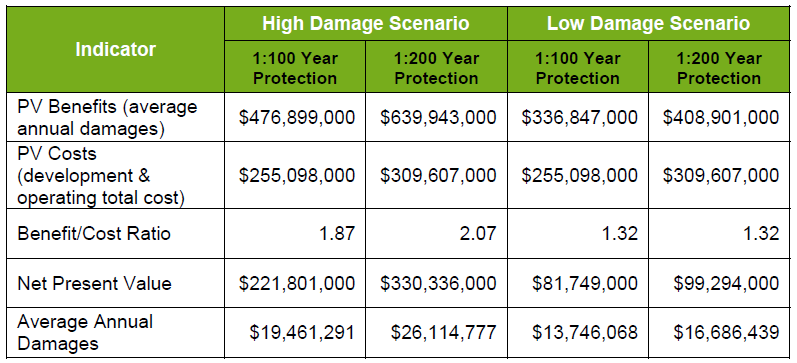Request for Feedback: Springbank Off-Stream Reservoir Benefit Cost Analysis
The following is a summary of the report “Benefit/Cost Analysis of Flood Mitigation Projects for the City of Calgary: Springbank Off-Stream Flood Storage”. Please read the entire report for a full understanding of the Benefit/Cost Analysis for this mitigation project.
The Springbank Off-Stream Reservoir, as originally proposed by AMEC in June 2014, will consist of three basic components:
- a river diversion structure
- a diversion channel and reservoir inlet structure
- an off-steam storage dam and reservoir
To accommodate a 1:100 year flood event the diversion channel will be designed to convey a peak flow of 300 m3/s.
Project Costs
The IBI report restates that the cost of the Springbank Off-Stream Reservoir project designed to accommodate a 1:100 year flood event, excluding the price of land acquisition, is estimated to be $159,768,000 based on 2012 construction price data. The IBI report bases its estimates on a preliminary engineering design and costs provided by the AMEC 2014 study. Additional subsurface soils investigations and more detailed hydrological assessment and topographic data are required to better establish concept details and size. The IBI analysis includes a 25% contingency as an attempt to account for additional costs that may be incurred as a result of further development of the engineering design.
If the Springbank Off-Stream Reservoir was designed to protect for the 2013 flood the size of the infrastructure would increase. The AMEC 2014 study states the result of these changes would add approximately $55 million to the project costs.
The land acquisition requirements in the IBI report are based on the conceptual design footprint including the diversion and storage reservoir to contain a 1:100 year event. This equated to approximately 1,760 acres of land, and may change during the detailed design phase.
To determine the cost of the land, IBI looked at 2014 MLS sales transactions in Springbank and other country residential developments in addition to opinions from real estate brokers. They found that typical agricultural land values vary from $4,000 to $8,000/acre. Using the upper bound of $10,000/acre land acquisition costs would be $17.6 million. However, if the land in question were to be developed prior to purchase the land acquisition costs could increase to $40 million. In order to be conservative the study uses a land acquisition cost of $40 million. For more details on this analysis please reference page 4 of the Springbank report (page 18 of the pdf).
Flood Damage Reduction
According to the IBI analysis, the implementation of the Springbank Off-Stream Reservoir project results in a reduction of average annual damages of the following:
- 1:100 year level of protection under the higher damage scenario: $19,461,291
- 1: 200 year level of protection under the higher damage scenario: $26,114,777
- 1:100 year level of protection under the lower damage scenario: $13,746,068
- 1: 200 year level of protection under the lower damage scenario: $16,686,439
Benefit / Cost Analysis
The figure below highlights the key results of the benefit / costs analysis of the Springbank Off-Stream Reservoir project. It should be noted that this analysis was conducted solely based on economic costs and does not take into account social costs or environmental impact.

The Springbank Off-Stream Reservoir project achieves a positive benefit/cost ratio under all four scenarios, suggesting that this is an economically effective project. As noted above, this analysis is based on a preliminary engineering design, and the numbers will very likely shift around as more detailed work is completed.
Request for feedback
What are your thoughts on the Springbank Off-Stream Reservoir project Benefit/Cost study?
Please contact the Alberta WaterPortal by email, or through the comments below. Feedback is accepted until March 31st. All feedback will be summarized and provided back on the WaterPortal and to the Government of Alberta.
